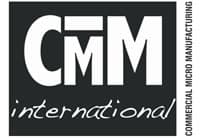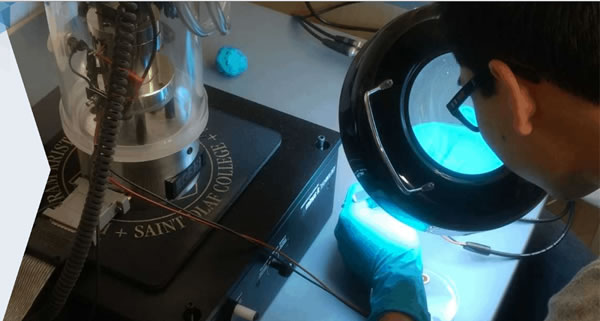
Commercial Micro Manufacturing - June 2020
St. Olaf College charts new depths for understanding friction in micromachines with help of Minus K's negative-stiffness vibration isolator
St. Olaf College, a liberal arts college in the US, is using a specially-designed, integrated nanoindenter-quartz microbalance in its research efforts to bridge the gap between the fundamental science of friction and the engineering of practical micromechanical systems. The college is a long-time advocate of negative-stiffness vibration isolators from US-based Minus K Technology and, as such, is relying on one to deliver the extreme stability required by the microbalance.

The nanoindenter-quartz microbalance mounted on a negative-stiffness vibration isolator. (Courtesy of St. Olaf College).
Scientists do not fully understand what causes friction and wear between two surfaces at the molecular level. Brian Borovsky, associate professor in the physics department at St. Olaf College, explained. "Whenever you are trying to design a micromechanical system, it is likely to include the fundamental machine parts of gears, gimbals, hinges, pistons and suspended beams that flex. Basic motions, which are the essence of mechanics, rely on these materials having durability and low or controllable friction. Mastering these forces that occur on such small-scale surfaces of micromachines is a considerable challenge. When the mechanical parts are so small, their properties are dominated by surface forces in a way that macroscopic machines are not. Entirely new questions are raised about how to keep them moving and protected from wear or breakage"
Silicon uniformity
Engineers have relied on extremely thin lubricant films to reduce friction and keep parts moving inside tiny silicon-constructed microelectromechanicaI systems (MEMS). However, these films have not been sufficiently effective in micromachines that rely on relatively fast-moving parts that are in contact with each other, such as gears, gimbals and pistons.
Since the introduction of the first micromechanical machines in the early 1980s, the vision has been to batch-fabricate these devices as silicon chips to link with circuitry that can be wirelessly connected. However, these small silicon machines disintegrate after just a few hours of operation.
"This technology has for some time been struggling to make it to the marketplace," said Professor Borovsky. "Literally, decades of research in both academia and business has been undertaken to understand friction and wear well enough at these micro- and nano-scales to effectively lubricate and provide wear protection."

A researcher performing a nanotribology experiment using the nanoindenter-quartz microbalance. (Courtesy of St. Olaf College).
The New research methodology
Professor Borovsky's work at St Olaf College focuses on micro/ nanotribology He has spent over two decades researching friction as applied to very tiny micromechanical machines, resulting in the development of instrumentation and a process that lest frictional properties of surfaces coated in ullrathm lubricants. His is one of the few labs that can measure the friction of micromachlne surfaces sliding past each other at exceptionally high speeds. It houses a range of scanning electron microscopy (SEM) and atomic force microscopy (AFM) equipment, but the focus instrumentation is the aforementioned nanoindenter-quartz microbalance. In Professor Borovsky's words: "It is unique and unlike anything else found in other laboratories studying friction."
Essentially, Professor Borovsky and his colleagues have custom-integrated two different tribology systems, namely a Hysitron TriboScope rigid nanoindenter probe, manufactured by Bruker, and a quartz crystal microbalance (QCM).
There is an aluminum oxide (sapphire) microsphere affixed to the indenter probe tip. The Indenter probe is loaded onto s surface that oscillates laterally back and forth under the probe tip at very high speeds. The resonant frequency and quality factor of the quartz crystal changes upon contact between the tip and the surface. These changes are determined as functions of oscillation amplitude at a fixed normal load. The increase in frequency of the quartz crystal is used to determine static friction. The decrease in quality factor of the quartz crystal is used to determine kinetic friction. The quartz crystal oscillates five million times per second, so it is easily able to achieve speeds and differentials comparable to the fastest micromachines.
![]()
A silicon microsphere enlarged 910x. (Courtesy of St. Olaf College).
Negative-stiffness vibration isolators
Since this level of research demands that vibrational interference is kept to an absolute minimum, the nanoindenter-quartz microbalance has been mounted on a negative-stiffness vibration isolator. St Olaf College has used negative-stiffness vibration isolators for all of its micra/nanotribology work since 2001.
These vibration isolators are compact and do not require electricity or compressed air, thus enabling sensitive instruments to be located anywhere that a laboratory or production facility needs to be set up, be it in a basement or on a building's vibration -compromised upper floors or rooftop. There are no chambers, motors or pumps and no maintenance is required because there is nothing to wear out. They operate purely In a passive mechanical mode.
The most significant advantage of negative-stiffness isolators is that they achieve a high level of isolation in multiple directions They afford the flexibility of custom tailoring resonant frequencies to 0 5 Hz* vertically and horizontally (with some versions at 1.5 Hz horizontally). *Note for an isolation system with a 0.5Hz natural frequency, isolation begins at 0.7Hz and improves with an increase in the vibration frequency. The natural frequency is more commonly used to describe the system.
Literally, decades of research in both academia and business has been undertaken to understand friction and wear well enough at these micro- and nano- scales to effectively lubricate and provide
wear protection.
Vertical-motion isolation is provided by a stiff spring that supports a weight load, combined with a negative-stiffness mechanism. The net vertical stiffness is made very low without affecting the static load-supporting capability of the spring. Beam-columns connected in series with the vertical-mot ion isolator provide horizontal-motion isolation. A beam-column behaves as a spring combined with a negative-stiffness mechanism. The result is a compact passive isolator, capable of very low vertical and horizontal natural frequencies and very high Internal structural frequencies.
Negative-stiffness isolators deliver very high performance, as measured by a vibration transmissibility curve. Vibration transmissibility is a measure of the vibrations that are transmitted through the isolator relative to the input vibrations. Negative-stiffness isolators that have been adjusted to 0.5 Hz achieve approximately 93 percent isolation efficiency at 2 Hz, 99 percent at 5 Hz and 99.7 percent at 10 Hz.
"Although our facilities have few external vibrations that could influence our experiments, like any laboratory, we are subject to vibration influence from HVAC systems, elevators, doors opening and closing, and even footfall near the instrumentation," said Professor Borovsky. "These isolators are simple to set up and operate, and they just continue to work, day after day.'

A quartz crystal before testing. (Courtesy of St. Olaf College).
Ongoing research
St. Olaf College's research into friction solutions for micromechamcal systems is set to continue thanks to the support and participation of some major corporations. Professor Borovsky concluded: "This work is motivated by the promise of micromechamcal systems. Micromechanics could be a really big deal, with influence in virtually every aspect of our lives, similar to microelectronics. There are many institutions and researchers devoted to unraveling the mysteries of friction wear on these small devices. Step by step, we are making forward progress."
St. Olaf College www.stolaf.edu
Minus K Technology www.minusk.com
|